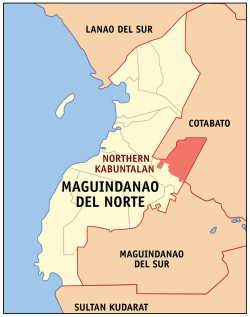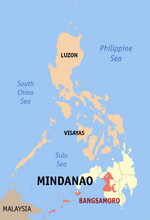Northern Kabuntalan
Northern Kabuntalan
اتار كبنتالن | |
|---|---|
| Municipality of Northern Kabuntalan | |
 Map of Maguindanao del Norte with Northern Kabuntalan highlighted | |
 | |
Location within the Philippines | |
| Coordinates: 7°12′06″N 124°28′29″E / 7.201661°N 124.474736°E | |
| Country | |
| Region | |
| Province | Maguindanao del Norte |
| District | Lone district |
| Founded | December 30, 2006 |
| Barangays | 11 (see Barangays) |
| Government | |
| • Type | Sangguniang Bayan |
| • Mayor | Datu Umbra B. Dilangalen |
| • Vice Mayor | Datu Mohammad Shaffie C. Bayam |
| • Representative | Sittie Shahara "Dimple" I. Mastura |
| • Municipal Council | Members |
| • Electorate | 14,474 voters (2022) |
| Area | |
| • Total | 106.77 km2 (41.22 sq mi) |
| Elevation | 10 m (30 ft) |
| Highest elevation | 38 m (125 ft) |
| Lowest elevation | 0 m (0 ft) |
| Population (2020 census)[3] | |
| • Total | 26,277 |
| • Density | 250/km2 (640/sq mi) |
| • Households | 4,448 |
| Economy | |
| • Income class | 5th municipal income class |
| • Poverty incidence | 40.26 |
| • Revenue | ₱ 112.5 million (2020) |
| • Assets | ₱ 88.69 million (2020) |
| • Expenditure | ₱ 108.7 million (2020) |
| • Liabilities | ₱ 29.31 million (2020) |
| Service provider | |
| • Electricity | Maguindanao Electric Cooperative (MAGELCO) |
| Time zone | UTC+8 (PST) |
| ZIP code | 9606 |
| PSGC | |
| IDD : area code | +63 (0)64 |
| Native languages | Maguindanao Ilianen Tagalog |
Northern Kabuntalan, officially the Municipality of Northern Kabuntalan (Maguindanaon: Inged nu Utara Kabuntalan; Tagalog: Bayan ng Northern Kabuntalan), is a 5th class municipality in the province of Maguindanao del Norte, Philippines. According to the 2020 census, it has a population of 26,277 people.[3]
During the second regular session of the first legislative assembly of the Autonomous Region in Muslim Mindanao, the regional legislature created Northern Kabuntalan out of 11 barangays of Kabuntalan, by virtue of Muslim Mindanao Autonomy Act No. 206,[5] which was subsequently ratified in a plebiscite held on December 30, 2006. The town was part of the province of Shariff Kabunsuan until its nullification by the Supreme Court in July 2008.
The ARMM law creating the municipality provides that its administrative center shall be established in barangay Tumaguinting.
Geography
[edit]Barangays
[edit]Northern Kabuntalan is politically subdivided into 11 barangays. Each barangay consists of puroks while some have sitios.
- Balong
- Damatog (Poblacion)
- Gayonga
- Guiawa
- Indatuan
- Kapimpilan
- Libungan
- Montay
- Paulino Labio
- Sabaken
- Tumaguinting
Climate
[edit]| Climate data for Northern Kabuntalan, Maguindanao | |||||||||||||
|---|---|---|---|---|---|---|---|---|---|---|---|---|---|
| Month | Jan | Feb | Mar | Apr | May | Jun | Jul | Aug | Sep | Oct | Nov | Dec | Year |
| Mean daily maximum °C (°F) | 32 (90) |
32 (90) |
33 (91) |
33 (91) |
31 (88) |
30 (86) |
30 (86) |
30 (86) |
31 (88) |
31 (88) |
31 (88) |
31 (88) |
31 (88) |
| Mean daily minimum °C (°F) | 22 (72) |
22 (72) |
22 (72) |
23 (73) |
24 (75) |
24 (75) |
23 (73) |
23 (73) |
23 (73) |
23 (73) |
23 (73) |
22 (72) |
23 (73) |
| Average precipitation mm (inches) | 38 (1.5) |
24 (0.9) |
29 (1.1) |
31 (1.2) |
50 (2.0) |
56 (2.2) |
52 (2.0) |
49 (1.9) |
39 (1.5) |
47 (1.9) |
54 (2.1) |
35 (1.4) |
504 (19.7) |
| Average rainy days | 10.1 | 7.5 | 10.0 | 11.5 | 19.7 | 20.8 | 19.4 | 18.5 | 16.3 | 18.5 | 18.4 | 12.8 | 183.5 |
| Source: Meteoblue (modeled/calculated data, not measured locally)[6] | |||||||||||||
Demographics
[edit]| Year | Pop. | ±% p.a. |
|---|---|---|
| 2007 | 22,170 | — |
| 2010 | 14,251 | −14.86% |
| 2015 | 25,232 | +11.49% |
| 2020 | 26,277 | +0.80% |
| Source: Philippine Statistics Authority[7][8][9][10] | ||
Economy
[edit]Poverty Incidence of Northern Kabuntalan
10
20
30
40
50
60
70
2006
47.40 2009
41.17 2012
63.95 2015
56.42 2018
65.50 2021
40.26 Source: Philippine Statistics Authority[11][12][13][14][15][16] |
References
[edit]- ^ Municipality of Northern Kabuntalan | (DILG)
- ^ "2015 Census of Population, Report No. 3 – Population, Land Area, and Population Density" (PDF). Philippine Statistics Authority. Quezon City, Philippines. August 2016. ISSN 0117-1453. Archived (PDF) from the original on May 25, 2021. Retrieved July 16, 2021.
- ^ a b Census of Population (2020). "Bangsamoro (BARMM)". Total Population by Province, City, Municipality and Barangay. Philippine Statistics Authority. Retrieved 8 July 2021.
- ^ "PSA Releases the 2021 City and Municipal Level Poverty Estimates". Philippine Statistics Authority. 2 April 2024. Retrieved 28 April 2024.
- ^ "Muslim Mindanao Autonomy Act No. 206; An Act Creating the Municipality of Northern Kabuntalan in the Province of Maguindanao, Providing Funds Therefor, and for Other Purposes" (PDF). Regional Legislative Assembly, Autonomous Region in Muslim Mindanao. Retrieved 27 January 2016.
- ^ "Northern Kabuntalan, Maguindanao : Average Temperatures and Rainfall". Meteoblue. Retrieved 19 January 2019.
- ^ Census of Population (2015). "ARMM – Autonomous Region in Muslim Mindanao". Total Population by Province, City, Municipality and Barangay. Philippine Statistics Authority. Retrieved 20 June 2016.
- ^ Census of Population and Housing (2010). "ARMM – Autonomous Region in Muslim Mindanao" (PDF). Total Population by Province, City, Municipality and Barangay. National Statistics Office. Retrieved 29 June 2016.
- ^ Censuses of Population (1903–2007). "ARMM – Autonomous Region in Muslim Mindanao". Table 1. Population Enumerated in Various Censuses by Province/Highly Urbanized City: 1903 to 2007. National Statistics Office.
- ^ "Province of Maguindanao". Municipality Population Data. Local Water Utilities Administration Research Division. Retrieved 17 December 2016.
- ^ "Poverty incidence (PI):". Philippine Statistics Authority. Retrieved December 28, 2020.
- ^ "City and Municipal Level Poverty Estimates; 2006 and 2009" (PDF). Philippine Statistics Authority. 3 August 2012.
- ^ "2012 Municipal and City Level Poverty Estimates" (PDF). Philippine Statistics Authority. 31 May 2016.
- ^ "Municipal and City Level Small Area Poverty Estimates; 2009, 2012 and 2015". Philippine Statistics Authority. 10 July 2019.
- ^ "PSA Releases the 2018 Municipal and City Level Poverty Estimates". Philippine Statistics Authority. 15 December 2021. Retrieved 22 January 2022.
- ^ "PSA Releases the 2021 City and Municipal Level Poverty Estimates". Philippine Statistics Authority. 2 April 2024. Retrieved 28 April 2024.
External links
[edit]- Northern Kabuntalan Profile at the DTI Cities and Municipalities Competitive Index
- MMA Act No. 205 : An Act Creating the Municipality of Northern Kabuntalan in the Province of Maguindanao
- Newly created provinces, municipalities, barangays, converted city Accessed on March 9, 2006.
- Philippine Standard Geographic Code
- Philippine Census Information
- Local Governance Performance Management System




